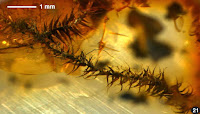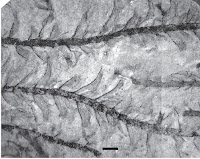Mosses are among the simplest and most ancient groups of plants. They lack flowers, seeds and roots, and only have very simple vascular systems. Despite this primitive nature they are still some of the most abundant plants today, due to their ability to colonise short-lived environments and live upon other plants.
In a paper published in the journal Phytotaxa on 3 May 2016, Jessica Beever of Landcare Research and Allan Fife of the Allan Herbarium describe a new species of Moss from the northern shore of the Manukau Harbour on the Auckland Isthmus of North Island, New Zealand.
The new species is placed in the genus Didymodon and given the specific name novae-zelandiae, in reference to the country where it was discovered. The Moss was found growing at a single site on a vertical sea-cliff made up of volcanic tuff (rock formed from ash) shaded by a canopy of Pōhutukawa (Metrosideros excelsa) trees. The plants brownish in colour and were small even for a Moss, with stems reaching 1-2 mm in length.
Didymodon novae-zelandiae habit with capsules. Beever & Fife (2016).
Areas of the cliff colonised by Didymodon novae-zelandiae were apparently more easily colonised by a larger Moss, Bryum clavatum, which was able to settle in such patches then competitively exclude the smaller Didymodon novae-zelandiae. This process, called succession by ecologists, is common in plat communities, where one plant modifies an environment in a way that makes it suitable for a second plant to take over and exclude the original coloniser. However the tuffa cliffs where the Mosses were found were extremely soft and poorly consolidated, with areas of the cliff surface regularly falling away and revealing fresh surface, suitable for colonisation by Didymodon novae-zelandiae but not Bryum clavatum. A more serious threat to the whole ecosystem appeared to come from invasive Kikuyu Grass (Cenchrus clandestinus) which was begging to settle soft unstable sediments at the base of the cliff.
Type locality of Didymodon novae-zelandiae on Manukau Harbour foreshore. Didymodon novae-zelandiae (position arrowed) on the cliff face, below a denser band of vegetation (mainly Bryum clavatum), some 1.5 m above high tide mark. The remains of trunks of trees buried by eruption of nearby Mount Maungataketake can be seen in the cliff base both to the right and left of the standing figure. The large Pōhutukawa tree (Metrosideros excelsa) to the right, above, has now fallen from the cliff. Jessica Beever in Beever & Fife (2016).
Didymodon novae-zelandiae was found growing only at a single site, on a poorly consolidated volcanic cliff. Such habitats are not common, even in volcanic New Zealand, however the small size of the Moss does leave the possibility that it is present in other environments and has been overlooked. For this reason Beever and Fife suggest that it be classified as an Data Deficient Endemic Plant for conservation purposes.
See also...
 Mosses from Late Eocene Rovno Amber. Mosses are thought to be among the most ancient of plant groups, and
still make up a significant proportion of all plant communities. They
are an ancient group, considerably predating vascular plants such as...
Mosses from Late Eocene Rovno Amber. Mosses are thought to be among the most ancient of plant groups, and
still make up a significant proportion of all plant communities. They
are an ancient group, considerably predating vascular plants such as... Two new species of Moss from the Permian of Brazil. Mosses (Bryophytes) are simple plants which lack vascular systems to
pump water and nutrients from a root system, instead relying on what
they can absorb through their leaves, and generally only reaching a few
cm in height. This means that they are at their...
Two new species of Moss from the Permian of Brazil. Mosses (Bryophytes) are simple plants which lack vascular systems to
pump water and nutrients from a root system, instead relying on what
they can absorb through their leaves, and generally only reaching a few
cm in height. This means that they are at their...
Follow Sciency Thoughts on Facebook.


